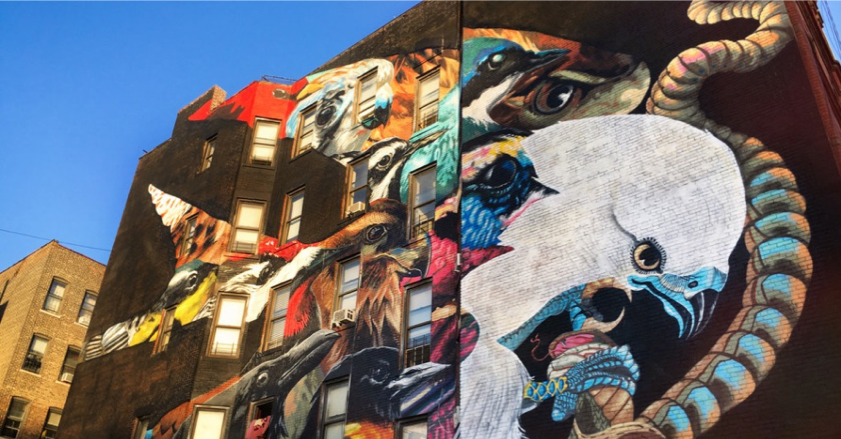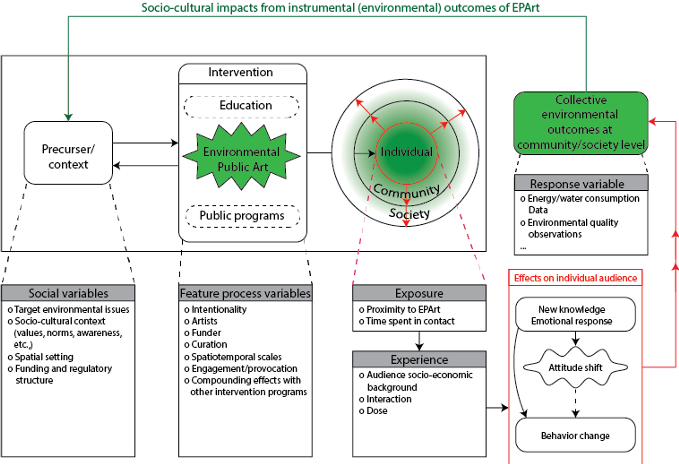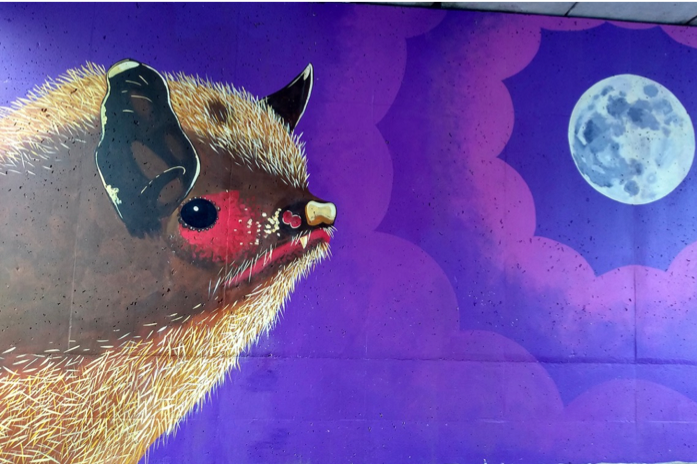
Imagine it’s a bustling summer afternoon in New York City. You can hear the cars and the people as you wander down Broadway. Turning a corner, you are suddenly confronted by a flock of large birds. The flock is not one species, but many—an army of Aves measuring fives stories high. You stare up at this brilliantly colored winged tapestry above you, and for a moment, you’re reminded of the birds you used to hear in this part of town or the crickets that no longer chirp.
Perhaps we have all had experiences like this one with the mural of birds threatened by climate change—an encounter with art that reminded us of what we stand to lose or ignited within us a sense of urgency. If art has the ability to speak to our emotions or help us recall our pasts, does it have the power to influence our futures? That is, can art be used as a tool to call individuals and communities to action to positively influence the trajectory of our planet, and if so, can that effect be measured? These are difficult and complex questions to answer, but inspired current and former postdoctoral researchers (and artists) at the National Socio-Environmental Synthesis Center (SESYNC) decided to create a workshop at the Center to try and find out. To do so, they convened researchers and practitioners from backgrounds including environmental and public art, environmental education, psychology, sustainability science, and the natural sciences to discuss their ideas.
Prior to the workshop, Bianca Lopez, Chris Field, and Se Jong Cho, all current or former postdoctoral researchers at SEYSNC and the principal investigators of the workshop, had heard opinions that evaluating the effects of public art would be impossible or fraught. How would they measure if environmental public art was “working”? Another potential challenge was coalescing a group of participants with such diverse areas of expertise: science and art. Would both feel comfortable enough to contribute equally to the projects’ development?

One tactic the group employed to overcome these challenges of diversity of thought and come to a consensus about how to measure environmental outcomes was learned from a participant who had been involved in organizing social movements. The strategy was to use different hand signals to convey to the others what they thought about a proposed solution on a sliding scale. This tactic enabled the group to make the most of their time, hashing out what needed further discussion and moving past points of consensus within the conceptual model. The accepted conceptual model emphasized people’s attitudes and values and served as the common ground for discussing how the participants believed public art influences people’s behavior and ultimately the environment. Another factor that contributed to the efficiency of the group’s progress was that the participants were either scientists who were also artists or artists who were interested in science. The result was a group of individuals who were practiced in the art of thinking outside the box.

During the workshop, participants focused on how to 1) define environmental public art and 2) develop a framework for measuring how environmental art affects people and the environment that can be a basis for future evaluation. The team plans to share those findings in an upcoming paper, which will form the basis for their other work.
Cho, Lopez, and Field said the team also has plans to focus on quantifying the goals, locations, and types of environmental public art that already exist across the United States and who potentially has access to them in a second paper. They will then use case studies to explore the potential for using existing data (e.g., data on water or energy use) to examine how much of an impact public art had on environmental outcomes, while controlling for other possible drivers of environmental change using statistical methods, for a third publication.
Overall, the group was excited about the potential for the outcomes of this workshop to provide researchers and practitioners with ideas and tools for quantifying the impact of public art. By the conclusion of the workshop, the researchers had high hopes that their methods can be used to better understand how to integrate public art into conservation efforts by providing guidelines for evaluating new art, as well as, approaches for evaluating existing art using data and methods that are currently available. Now, all that is needed, according to Cho, Lopez, and Field, is “a group of motivated people to synthesize the data.”